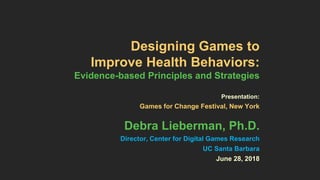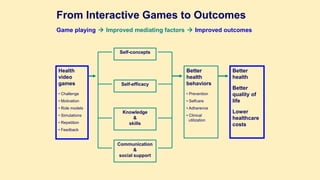Designing Games to Improve Health Behaviors: Evidence-based Principles and Strategies
- 1. Designing Games to Improve Health Behaviors: Evidence-based Principles and Strategies Presentation: Games for Change Festival, New York Debra Lieberman, Ph.D. Director, Center for Digital Games Research UC Santa Barbara June 28, 2018
- 2. Games Interactive, adaptive, immersive, impactful experiences Challenge to reach a goal Feedback on progress New platforms, displays, sensors, data sources
- 3. Media are similar to real life ’é¦ We feel ŌĆ£presentŌĆØ in media worlds ’é¦ Games can have compelling stories and characters, interactions, transactions, simulations, constructions, collaborations, social connections with other people ’é¦ Games can be embodied in robots, plush toys ’é¦ We experience media events ’é¦ Our emotional responses to media events and events in real life are remarkably similar
- 4. ResearcherŌĆÖs role in game design ’é¦ Specify the game concept and goals ’é¦ Evidence-based game design strategies to achieve goals ’é¦ Proposals for grants, investments, gifts ’é¦ Play testing and game revision during production ’é¦ Evaluation research to measure outcomes ’é¦ Publish and present evaluation research findings ’é¦ Help the design team keep up with current research
- 5. (1) Specify the game concept and goals Know target players ’é¦ Interests, abilities, culture ’é¦ Self-concepts ’é¦ Game platforms & genres they prefer ’é¦ Formal or informal setting for game play ’é¦ Current health behaviors and health risks ’é¦ Barriers to good health behaviors (lifestyle, prevention, self-care) ’é¦ Do they want to improve this health behavior? Why or why not? ’é¦ (Players should be design partners!)
- 6. (2) Specify the game concept and goals Behavioral wish-list from medical experts ’é¦ Patient behaviors that must change ’é¦ What patients need to know/understand ’é¦ Attitudes that patients could change ’é¦ Self-concepts that would benefit patients ’é¦ What motivates patients to improve behaviors
- 7. (3) Specify the game concept and goals Which behaviors ’āĀ Game goals and can a game improve? intended outcomes
- 8. Focus the design on specific outcomes How will game play enhance the outcomes? Standalone game or integrated with other media, games, or direct experiences? ’ü« Must one game achieve all outcomes?
- 9. Mediating factors can change behavior Game ’āĀ Mediating ’āĀ Behavior ’āĀ Health factor outcome Examples of mediating factors ’é¦ Perceived susceptibility ’é¦ Perceived stigma ’é¦ Skill development ’é¦ Self-efficacy; response efficacy
- 10. From Interactive Games to Outcomes Game playing ’āĀ Improved mediating factors ’āĀ Improved outcomes Better health behaviors ŌĆó Prevention ŌĆó Selfcare ŌĆó Adherence ŌĆó Clinical utilization Better health Better quality of life Lower healthcare costs Health video games ŌĆó Challenge ŌĆó Motivation ŌĆó Role models ŌĆó Simulations ŌĆó Repetition ŌĆó Feedback Self-concepts Communication & social support Knowledge & skills Self-efficacy
- 11. Evidence-based design Draws from theory and research findings to improve: ’é¦ Engagement ’é¦ Motivation ’é¦ Attitude change ’é¦ Self-concept change ’é¦ Learning ’é¦ Skill development ’é¦ Behavior change
- 12. Engagement Elaboration Likelihood Model ’ü« (ELM) ŌĆō Involvement Transportation Theory Homophily ’ü« Attention to characters like me Self-referential encoding ’ü« Learn as the content pertains to me Tailoring, personalization, adaptiveness, feedback
- 13. Social connection is engaging Self Determination Theory Social comparison (leaderboard) Social support, coaching Teach a character
- 14. Motivation Extrinsic / Intrinsic ’ü« Points, level-ups vs. deep personal goals ’ü« Different messaging for each ’ü« Tie them together Game challenge is motivating ’ü« In the game and in daily life behaviors See yourself as avatar ’ü« Self-modeling ŌĆō exercise and lose weight ŌĆō transfers to actual exercise ’ü« Future self ŌĆō save more for retirement
- 15. Attitude change Empathy ’ü« Your avatar cannot avoid homelessness ’ü« Your avatar struggles with health issue Procedural rhetoric Vicarious experience ŌĆō Re-Mission ’ü« Social Cognitive Theory ’ü« Improves self-efficacy for cancer care ’ü« Players without cancer now see it as a serious problem ŌĆō inspired to improve lifestyle habits
- 16. Self-concept change Rehearsal ’āĀ Self-efficacy Role modeling Feedback on success Avatar of self ’ü« Experiment with new identities and feel empathy ’ü« Aspirational avatar, project oneŌĆÖs ideal identity and experience it ’ü« The Proteus Effect
- 17. Learning and skill development Simulations of real-life challenges ’ü« Climate games ŌĆō use resources wisely or not ŌĆō see consequences ’ü« Health games ŌĆōtreat a patient (or self as avatar) ŌĆō see effects Feedback tied to interests, values Become your avatar ’ü« Hellblade challenges the player to think like a psychotic, in order to win
- 18. Behavior change Rehearsal of habits, skills, adherence Game as springboard for discussion Two-player, cooperative challenges Stages of Change ŌĆō five stages ’ü« Player segmentation Inspired, mobile game, quit smoking ’ü« External accountability ’ü« Friends hold you accountable ’ü« Friends cheer you on, celebrate
- 19. Behavior change ŌĆō sensors Mindlight, for anxiety-disordered children ages 8-12 ’é¦ Players must overcome their fears ’é¦ Neurofeedback headset ’é¦ Respond to scary events, threats ’é¦ Practice relaxation, focus, attention allocation ’é¦ Develop new habits of mind
- 20. Behavior change ŌĆō narrative Dramatic stories are engaging, arousing, transporting, memorable ’é¦ We care about the characters ’é¦ First-hand experience when our own avatar is a character ’é¦ Emotional and physiological responses ’é¦ Stories enhance attention, immersion, persuasion, learning, skill transfer, recall of facts
- 21. Behavior change ŌĆō neurogames diagnose, treat, and assess cognition ’é¦ Project Evo for ADHD ŌĆō improves attention and control ’é¦ Storytelling and feedback ’é¦ Challenges and rehearses neural systems ’é¦ Adapts to playerŌĆÖs abilities ’é¦ FDA approval
- 22. Behavior change ŌĆō active games Require physical activity ’é¦ Physical activity is the interface ’é¦ Or real-world activities supported by mobile content, AR, VR, robots ’é¦ Can improve physical activity habits, social connections, cognitive functioning, cardio- vascular health ’é¦ Tele-rehabilitation
- 23. Behavior change ŌĆō social
- 24. Behavior change ŌĆō social
- 25. Behavior change ŌĆō inter-generational
- 26. Behavior change ŌĆō better communication with medical team about health concerns
- 27. A few overarching principles and strategies Didactic content is the least of it Player experience is key ŌĆō in the game and outside it Focus on a few specific goals for behavior change ’ü« Be redundant ŌĆō design several game features and game mechanics to address each goal Address playerŌĆÖs intrinsic values and motivations Iterative testing and redesign are essential A game can be fun and effective ŌĆō donŌĆÖt squelch the fun Learning, skill development, striving, problem-solving, failing/retrying are fun ŌĆō not stealth, not broccoli covered in chocolate sauce!
- 28. Proverb Tell me and I forget. Show me and I remember. Involve me and I understand.
- 29. Thank you Debra Lieberman, Ph.D. Director, Center for Digital Games Research UC Santa Barbara debra.lieberman@ucsb.edu www.cdgr.ucsb.edu Twitter: @DebLieberman Twitter: @GamesResearch





























